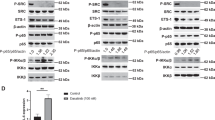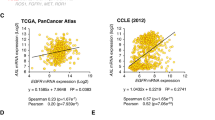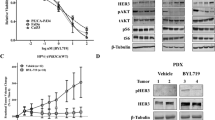Abstract
Overexpression of epidermal growth factor receptor (EGFR) is found in over 80% of head and neck squamous cell carcinomas (HNSCC) and associated with poor clinical outcomes. EFGR selective tyrosine kinase inhibitors (TKIs) or antibodies have recently emerged as promising treatments for solid tumors, including HNSCC, though the response rate to these agents is low. p53 upregulated modulator of apoptosis (PUMA), a BH3-only Bcl-2 family protein, is required for apoptosis induced by p53 and various chemotherapeutic agents. In this study, we show that PUMA induction is correlated with EGFR-TKI sensitivity, and is mediated through the p53 family protein p73β and inhibition of the PI3K/AKT pathway. In some HNSCC cells, the gefitinib-induced degradation of oncogenic ΔNp63 seems to facilitate p73-mediated PUMA transcription. Inhibiting PUMA expression by small hairpin RNA (shRNA) impairs gefitinib-induced apoptosis. Furthermore, PUMA or BH3 mimetics sensitize HNSCC cells to gefitinib-induced apoptosis. Our results suggest that PUMA induction through p73 represents a new mechanism of EGFR inhibitor-induced apoptosis, and provide potential ways for enhancing and predicting the sensitivity to EGFR-targeted therapies in HNSCC.
This is a preview of subscription content, access via your institution
Access options
Subscribe to this journal
Receive 50 print issues and online access
$259.00 per year
only $5.18 per issue
Buy this article
- Purchase on Springer Link
- Instant access to full article PDF
Prices may be subject to local taxes which are calculated during checkout






Similar content being viewed by others
References
Barbieri CE, Barton CE, Pietenpol JA . (2003). Delta Np63 alpha expression is regulated by the phosphoinositide 3-kinase pathway. J Biol Chem 278: 51408–51414.
Barbieri CE, Pietenpol JA . (2006). p63 and epithelial biology. Exp Cell Res 312: 695–706.
Bonner JA, Harari PM, Giralt J, Azarnia N, Shin DM, Cohen RB et al. (2006). Radiotherapy plus cetuximab for squamous-cell carcinoma of the head and neck. N Engl J Med 354: 567–578.
Bunz F, Hwang PM, Torrance C, Waldman T, Zhang Y, Dillehay L et al. (1999). Disruption of p53 in human cancer cells alters the responses to therapeutic agents. J Clin Invest 104: 263–269.
Choong NW, Cohen EE . (2006). Epidermal growth factor receptor directed therapy in head and neck cancer. Crit Rev Oncol Hematol 57: 25–43.
Chun PY, Feng FY, Scheurer AM, Davis MA, Lawrence TS, Nyati MK . (2006). Synergistic effects of gemcitabine and gefitinib in the treatment of head and neck carcinoma. Cancer Res 66: 981–988.
Citri A, Yarden Y . (2006). EGF-ERBB signalling: towards the systems level. Nat Rev Mol Cell Biol 7: 505–516.
Costa DB, Halmos B, Kumar A, Schumer ST, Huberman MS, Boggon TJ et al. (2007). BIM mediates EGFR tyrosine kinase inhibitor-induced apoptosis in lung cancers with oncogenic EGFR mutations. PLoS Med 4: 1669–1679; discussion 1680.
Cragg MS, Kuroda J, Puthalakath H, Huang DC, Strasser A . (2007). Gefitinib-induced killing of NSCLC cell lines expressing mutant EGFR requires BIM and can be enhanced by BH3 mimetics. PLoS Med 4: 1681–1689; discussion 1690.
Gong Y, Somwar R, Politi K, Balak M, Chmielecki J, Jiang X et al. (2007). Induction of BIM is essential for apoptosis triggered by EGFR kinase inhibitors in mutant EGFR-dependent lung adenocarcinomas. PLoS Med 4: e294.
Hanahan D, Weinberg RA . (2000). The hallmarks of cancer. Cell 100: 57–70.
Huang C, Schmid PC, Ma WY, Schmid HH, Dong Z . (1997). Phosphatidylinositol-3 kinase is necessary for 12-O-tetradecanoylphorbol-13-acetate-induced cell transformation and activated protein 1 activation. J Biol Chem 272: 4187–4194.
Jeffers JR, Parganas E, Lee Y, Yang C, Wang J, Brennan J et al. (2003). Puma is an essential mediator of p53-dependent and -independent apoptotic pathways. Cancer Cell 4: 321–328.
Jemal A, Siegel R, Ward E, Murray T, Xu J, Thun MJ . (2007). Cancer statistics, 2007. CA Cancer J Clin 57: 43–66.
Kalyankrishna S, Grandis JR . (2006). Epidermal growth factor receptor biology in head and neck cancer. J Clin Oncol 24: 2666–2672.
Karst AM, Dai DL, Martinka M, Li G . (2005). PUMA expression is significantly reduced in human cutaneous melanomas. Oncogene 24: 1111–1116.
Kitada S, Leone M, Sareth S, Zhai D, Reed JC, Pellecchia M . (2003). Discovery, characterization, and structure-activity relationships studies of proapoptotic polyphenols targeting B-cell lymphocyte/leukemia-2 proteins. J Med Chem 46: 4259–4264.
Labi V, Erlacher M, Kiessling S, Villunger A . (2006). BH3-only proteins in cell death initiation, malignant disease and anticancer therapy. Cell Death Differ 13: 1325–1338.
Liu B, Fang M, Schmidt M, Lu Y, Mendelsohn J, Fan Z . (2000). Induction of apoptosis and activation of the caspase cascade by anti-EGF receptor monoclonal antibodies in DiFi human colon cancer cells do not involve the c-jun N-terminal kinase activity. Br J Cancer 82: 1991–1999.
Matheny KE, Barbieri CE, Sniezek JC, Arteaga CL, Pietenpol JA . (2003). Inhibition of epidermal growth factor receptor signaling decreases p63 expression in head and neck squamous carcinoma cells. Laryngoscope 113: 936–939.
Ming L, Sakaida T, Yue W, Jha A, Zhang L, Yu J . (2008). Sp1 and p73 Activate PUMA Following Serum Starvation. Carcinogenesis 29: 1878–1884.
Muller S, Su L, Tighiouart M, Saba N, Zhang H, Shin DM et al. (2008). Distinctive E-cadherin and epidermal growth factor receptor expression in metastatic and nonmetastatic head and neck squamous cell carcinoma: predictive and prognostic correlation. Cancer 113: 97–107.
Nakano K, Vousden KH . (2001). PUMA, a novel proapoptotic gene, is induced by p53. Mol Cell 7: 683–694.
Oliver CL, Bauer JA, Wolter KG, Ubell ML, Narayan A, O’Connell KM et al. (2004). in vitro effects of the BH3 mimetic, (-)-gossypol, on head and neck squamous cell carcinoma cells. Clin Cancer Res 10: 7757–7763.
Pietenpol JA, Papadopoulos N, Markowitz S, Willson JK, Kinzler KW, Vogelstein B . (1994). Paradoxical inhibition of solid tumor cell growth by bcl2. Cancer Res 54: 3714–3717.
Qiu W, Carson-Walter EB, Liu H, Epperly M, Greenberger JS, Zambetti GP et al. (2008). PUMA regulates intestinal progenitor cell radiosensitivity and gastrointestinal syndrome. Cell Stem Cell 2: 576–583.
Rocco JW, Leong CO, Kuperwasser N, DeYoung MP, Ellisen LW . (2006). p63 mediates survival in squamous cell carcinoma by suppression of p73-dependent apoptosis. Cancer Cell 9: 45–56.
She QB, Solit DB, Ye Q, O’Reilly KE, Lobo J, Rosen N . (2005). The BAD protein integrates survival signaling by EGFR/MAPK and PI3K/Akt kinase pathways in PTEN-deficient tumor cells. Cancer Cell 8: 287–297.
Sordella R, Bell DW, Haber DA, Settleman J . (2004). Gefitinib-sensitizing EGFR mutations in lung cancer activate anti-apoptotic pathways. Science 305: 1163–1167.
Sun Q, Sakaida T, Yue W, Gollin SM, Yu J . (2007). Chemosensitization of head and neck cancer cells by PUMA. Mol Cancer Ther 6: 3180–3188.
Villunger A, Michalak EM, Coultas L, Mullauer F, Bock G, Ausserlechner MJ et al. (2003). p53- and drug-induced apoptotic responses mediated by BH3-only proteins Puma and Noxa. Science 302: 1036–1038.
Wang G, Nikolovska-Coleska Z, Yang CY, Wang R, Tang G, Guo J et al. (2006a). Structure-based design of potent small-molecule inhibitors of anti-apoptotic Bcl-2 proteins. J Med Chem 49: 6139–6142.
Wang H, Qian H, Yu J, Zhang X, Zhang L, Fu M et al. (2006b). Administration of PUMA adenovirus increases the sensitivity of esophageal cancer cells to anticancer drugs. Cancer Biol Ther 5: 380–385.
Wang JL, Liu D, Zhang ZJ, Shan S, Han X, Srinivasula SM et al. (2000). Structure-based discovery of an organic compound that binds Bcl-2 protein and induces apoptosis of tumor cells. Proc Natl Acad Sci USA 97: 7124–7129.
Wang P, Yu J, Zhang L . (2007). The nuclear function of p53 is required for PUMA-mediated apoptosis induced by DNA damage. Proc Natl Acad Sci USA 104: 4054–4059.
Wolter KG, Wang SJ, Henson BS, Wang S, Griffith KA, Kumar B et al. (2006). (−)-gossypol inhibits growth and promotes apoptosis of human head and neck squamous cell carcinoma in vivo. Neoplasia 8: 163–172.
Wu B, Qiu W, Wang P, Yu H, Cheng T, Zambetti GP et al. (2007). p53 independent induction of PUMA mediates intestinal apoptosis in response to ischaemia-reperfusion. Gut 56: 645–654.
You H, Pellegrini M, Tsuchihara K, Yamamoto K, Hacker G, Erlacher M et al. (2006). FOXO3a-dependent regulation of Puma in response to cytokine/growth factor withdrawal. J Exp Med 203: 1657–1663.
Yu J, Wang P, Ming L, Wood MA, Zhang L . (2007). SMAC/Diablo mediates the proapoptotic function of PUMA by regulating PUMA-induced mitochondrial events. Oncogene 26: 4189–4198.
Yu J, Wang Z, Kinzler KW, Vogelstein B, Zhang L . (2003). PUMA mediates the apoptotic response to p53 in colorectal cancer cells. Proc Natl Acad Sci USA 100: 1931–1936.
Yu J, Yue W, Wu B, Zhang L . (2006). PUMA sensitizes lung cancer cells to chemotherapeutic agents and irradiation. Clin Cancer Res 12: 2928–2936.
Yu J, Zhang L . (2003). No PUMA, no death: implications for p53-dependent apoptosis. Cancer Cell 4: 248–249.
Yu J, Zhang L . (2004). Apoptosis in human cancer cells. Curr Opin Oncol 16: 19–24.
Yu J, Zhang L, Hwang PM, Kinzler KW, Vogelstein B . (2001). PUMA induces the rapid apoptosis of colorectal cancer cells. Mol Cell 7: 673–682.
Zhang L, Ming L, Yu J . (2007). BH3 mimetics to improve cancer therapy; mechanisms and examples. Drug Resist Updat 10: 207–217.
Acknowledgements
We thank other members of our laboratories for helpful discussion and advice. We also thank Drs Cary Wu, Susanne M Gollin (University of Pittsburgh), Bert Vogelstein (HHMI and Sidney Kimmel Cancer Center at Johns Hopkins), David Sidransky (Sidney Kimmel Cancer Center at Johns Hopkins), and Carol Prives (Columbia University) for reagents. This work is supported in part by NIH grant CA129829, P50CA097190 (Head and Neck SPORE career development award) and those from ACGT and FAMRI (J Yu), and by NIH grants CA106348, CA121105, and American Cancer Society grant RSG-07-156-01-CNE (L Zhang).
Author information
Authors and Affiliations
Corresponding author
Additional information
Supplementary Information accompanies the paper on the Oncogene website (http://www.nature.com/onc)
Supplementary information
Rights and permissions
About this article
Cite this article
Sun, Q., Ming, L., Thomas, S. et al. PUMA mediates EGFR tyrosine kinase inhibitor-induced apoptosis in head and neck cancer cells. Oncogene 28, 2348–2357 (2009). https://doi.org/10.1038/onc.2009.108
Received:
Revised:
Accepted:
Published:
Issue Date:
DOI: https://doi.org/10.1038/onc.2009.108
Keywords
This article is cited by
-
EGFR-induced suppression of HPV E6/E7 is mediated by microRNA-9-5p silencing of BRD4 protein in HPV-positive head and neck squamous cell carcinoma
Cell Death & Disease (2022)
-
BRD9 inhibition promotes PUMA-dependent apoptosis and augments the effect of imatinib in gastrointestinal stromal tumors
Cell Death & Disease (2021)
-
AMPK activation overcomes anti-EGFR antibody resistance induced by KRAS mutation in colorectal cancer
Cell Communication and Signaling (2020)
-
RETRACTED ARTICLE: Cabozantinib induces PUMA-dependent apoptosis in colon cancer cells via AKT/GSK-3β/NF-κB signaling pathway
Cancer Gene Therapy (2020)
-
Targeting apoptosis in cancer therapy
Nature Reviews Clinical Oncology (2020)



